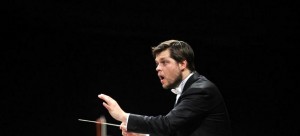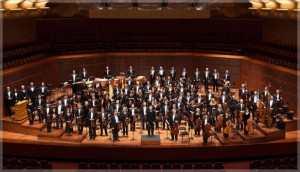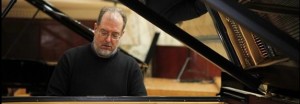COOL RACH TAKES BACK SEAT TO HOT BARTÓK
It’s a strange thing about expectations. San Francisco Symphony made it clear who the headliner was for last night’s program, but Slovakian guest conductor Juraj Valčuha’s rendition of Bartók’s The Miraculous Mandarin outdid pianist Garrick Ohlsson’s Rach III.
Valčuha kicked-off the first half with Steven Stucky’s brief, energetic Jeu de timres. The piece was exciting, if slightly overfull, an embarrassment of riches stuffed into a four-minute time frame. Stucky is quoted as saying, “Only if I write music that makes my blood race, that makes the hair on the back of my neck stand-up, do I have any hope of writing something truthful enough to have the same effect on another listener.” I would say Stucky achieved his goal here, and it was a perfect prelude for what came next.
Closing the first half of the concert was the evening’s highlight, Béla Bartók’s The Miraculous Mandarin, Opus 19, a 1919 ballet based on a seamy, at-that-time scandalous scenario written by Hungarian playwright Menyhért Lengyel (1880–1974). The story centers around three cutthroats who force a beautiful girl to lure men into their lair, whereupon they rob them. The third “visitor” is a wealthy Chinese man, whom the girl entertains by dancing. Arousing his passion, she shrinks from his advances, giving the thugs an opportunity to attack him, rob him, smother him with a quilt and stab him with a sword, alas to no avail. They cannot kill the Mandarin while his passion for the girl lives. Following her instinct, the girl finally gives in to his desire, and only when satiated does he collapse and die.
Valčuha’s lively, almost athletic style of conducting shone on this piece. His expressive face, stark intensity, and solid connection with the entire orchestra made the conductor and ensemble appear as one living, breathing organism. The dark, dense music was by turns near-claustrophobic, sensuously erotic; and powerfully foreboding—even terrifying. Bartók captured the mood and specific action of the story, sweeping the audience into a riveting, hair-raising musical journey. Watching Valčuha conduct, you could almost hear the simultaneous heartbeat of him and the players. SFS yet again demonstrated why they are considered one of the world’s premiere musical ensembles.
SFS’s homepage said, ‘“Titan among Titans of the piano’ (San Francisco Classical Voice), Grammy award-winning Garrick Ohlsson conquers Rachmaninoff’s Third Piano Concerto.” A titan indeed; at six-foot-four, Ohlsson is probably the only classical pianist working today who can make a 9-foot Steinway Grand look small. Needless to say, the “titan” reference no doubt had more to do with Ohlsson’s prodigious accomplishments, as one of the world’s premier interpreters of a broad expanse of classical piano literature, most notably that of Frederic Chopin. After becoming the only American to date to win the International Chopin Piano Competition (1970), Ohlsson went on to record much of Chopin’s work, culminating in the release of The Complete Works of Chopin on the Hyperion label.
Indeed, Ohlsson’s technical virtuosity and unflappable demeanor were in fine form, as he played with austere and crisply cool efficiency. Therein lay the problem. Rachmaninoff’s Piano Concerto No. 3 in D minor, Opus 30 is a composition of great dynamic range, famous for passages of placid simplicity alternating with barrages of great ferocity and, dare I say Russian, passion. Without the presence of the towering mountains, the lovely, cool valleys become nothing more than flat places in the landscape, and eventually perspective is lost.
Ultimately the piece became unbalanced. Ohlsson was clearly choosing texture, restraint, and precision over passion and emotional connection. To achieve this, he jettisoned all but the tiniest amount of theatricality and high emotions during the famously “big” passages; an artistic choice to be sure, but one that excluded much of Rachmaninoff’s dramatic intent. Ultimately, the performance of a famously dynamic piano concerto had the orchestral accompaniment noticeably more compelling than the pianist.
The sold-out SF Symphony audience responded with passion, culminating in an encore. Interestingly enough, during Prelude in C Sharp Minor, Rachmaninoff’s most famous solo piano composition, Ohlsson not only doled out his trademark technical expertise but he did so with great depth and passion.
Garrick Ohlsson plays Rachmaninoff
San Francisco Symphony
Juraj Valčuha, conductor
Davies Symphony Hall, 201 Van Ness Avenue
scheduled to end on September 12, 2014
for tickets, call 415-864-6000 or visit www.sfsymphony.org




